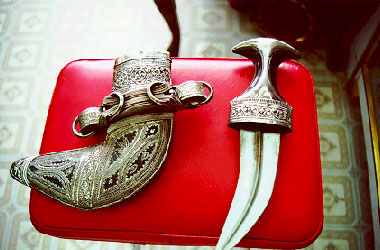HISTORY Little is known about Oman's pre-Islamic past but it is clear
from recent archaeological discoveries and research that early civilisations existed at
least 500 years ago. The Coming of Islam and the Early Imamate The call of the Prophet Mohammed to the Omanis to become
Muslims altered the course of their history. It was in about 630 AD that Amr Ibn al-As
arrived in Oman bearing a letter from the Prophet to Abd and Jaifar, the two sons of
al-Julanda, who ruled Oman jointly. Having embraced Islam, they were instrumental in
defeating the Persians. Portuguese Occupation In the early 16th century after the Portuguese under Vasco de Gama has discovered the sea route round the Cape of Good Hope to India, they occupied Muscat for a century and a half in order to dominate the trade which had until then been an Arab monopoly. The Portuguese were expelled from Muscat in 1650 by Sultan bin Saif al-Yarubi. The Ya'aruba Dynasty Since the expulsion of the Portuguese no other foreign power has ever occupied Oman, apart from a brief period when the Persians made a partial occupation. The Ya'aruba Imams introduced a period of renaissance in Omani fortunes both at home and abroad, uniting the country and bringing prosperity. It was under the Ya'aruba dynasty that many of the imposing castles and beautiful buildings that have been restored recently, such as the fort at Nizwa and the Palace at Jabrin, were built. Civil War Unfortunately, on the death in 1718 of the Imam, Sultan bin Saif II, civil war broke out over the election of his successor. Persian troops occupied Muttrah and Muscat but failed to take Sohar which was defended by Ahmad bin Said, who continued to fight the Persians and drive them from Oman after the civil was had ended. The Al bu Said Dynasty In 1744 Ahmad bin Said, who was a man of outstanding personality and courage, was elected Imam. He faced a number of difficulties in reconciling the rival factions after the civil war, but he managed to build up the Omani navy into a power to be reckoned with, personality leading expeditions against pirates and driving the Persians out of Basra. When he died in 1783, his son Said was elected Imam but he was not popular, being replaced by his son Hamad, who had been de facto ruler in Muscat while his father remained in Rostaq. Hamad died suddenly in 1792 and his uncle, Sayyid Sultan bin Ahmed, assumed power until his death in 1804. He had exercised such tight control over Oman and trade in the Gulf that European powers dealth with him as the effective ruler of the country. Sayyid Said bin Sultan Sayyid Sultan was succeeded by his Son, Sayyid Said bin
Sultan, who consolidated his father's achievements at home and abroad during his reign
from 1804-1856. It was in this period that Oman reached its zenith as a regional power
with possessions on both sides of the Gulf and in East Africa. Sayyid Said concentrated on
developing his country's economy and commerce. He made Zanzibar his second capital and
concluded agreements with the European powers, as well as sending a special envoy to the
United States, making Oman the first Arab state to establish diplomatic relations with
that country.
|

